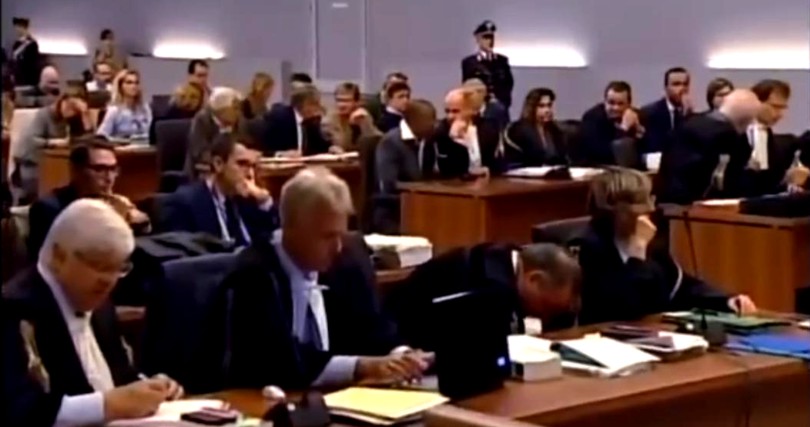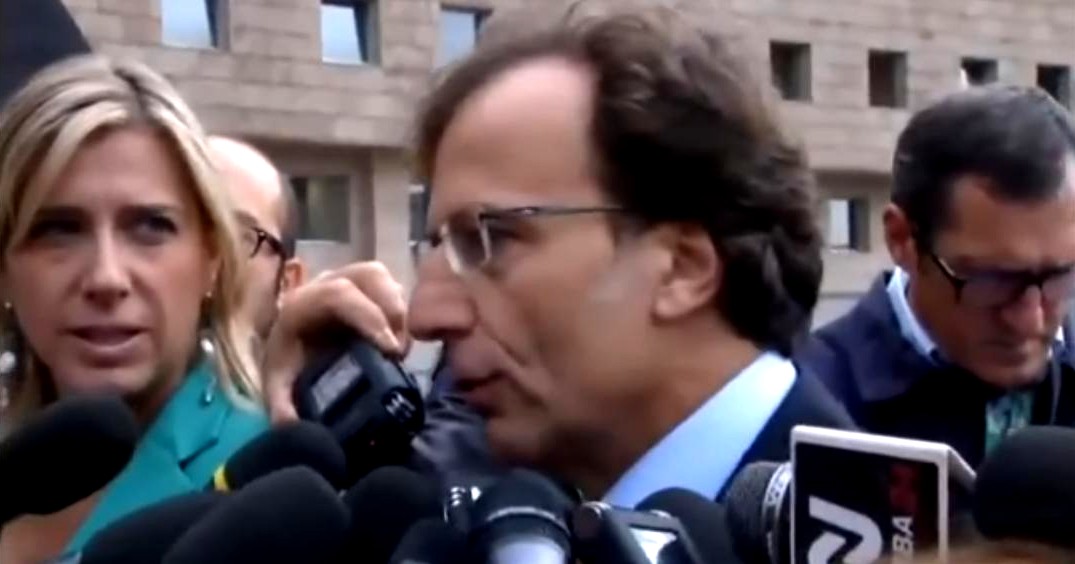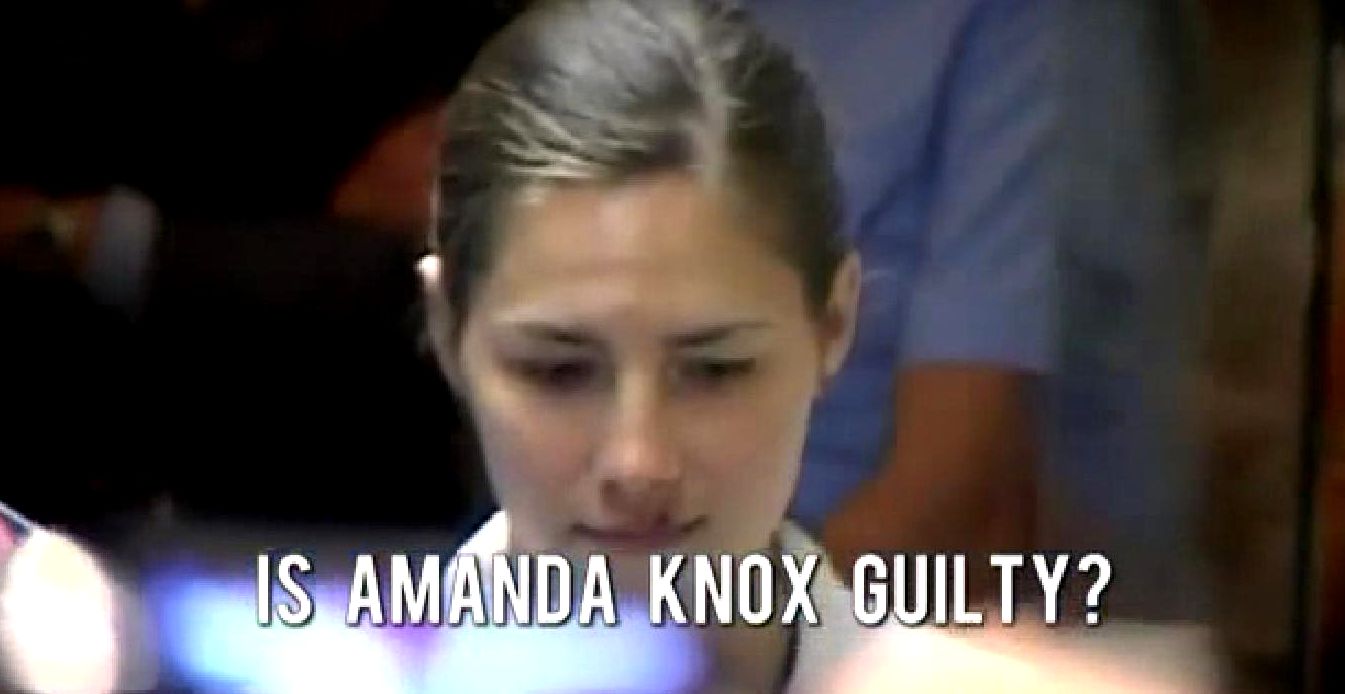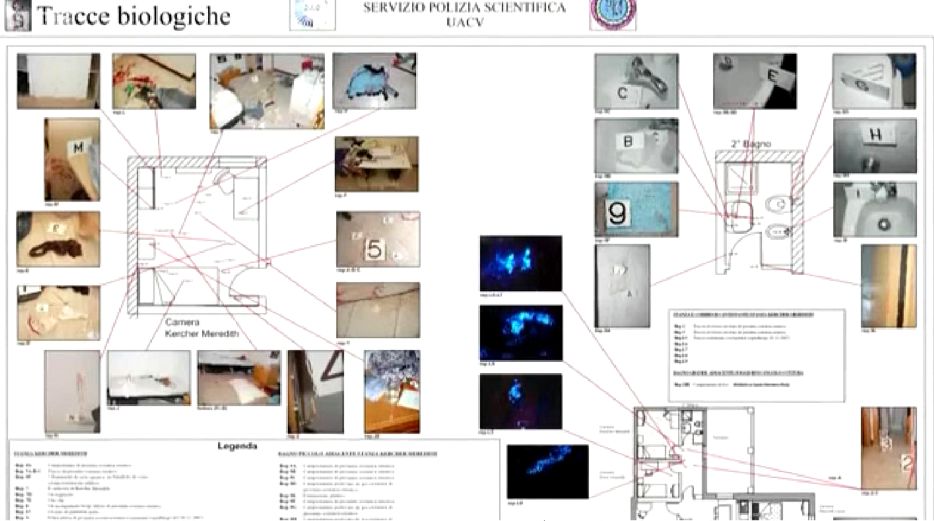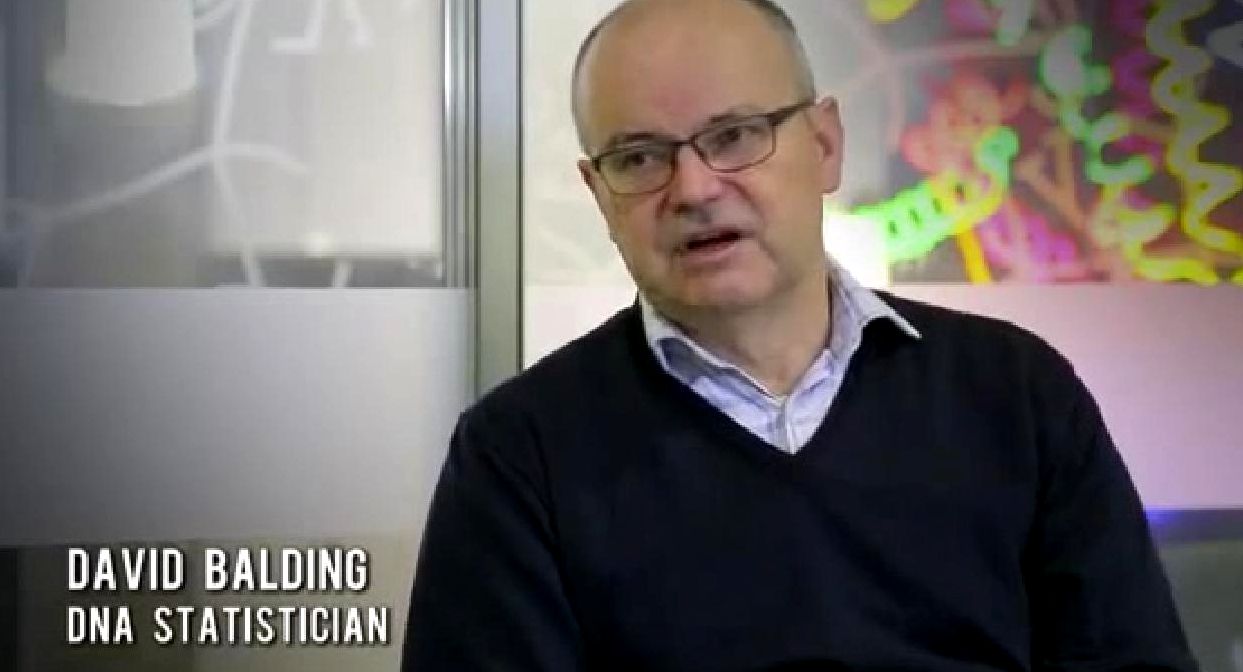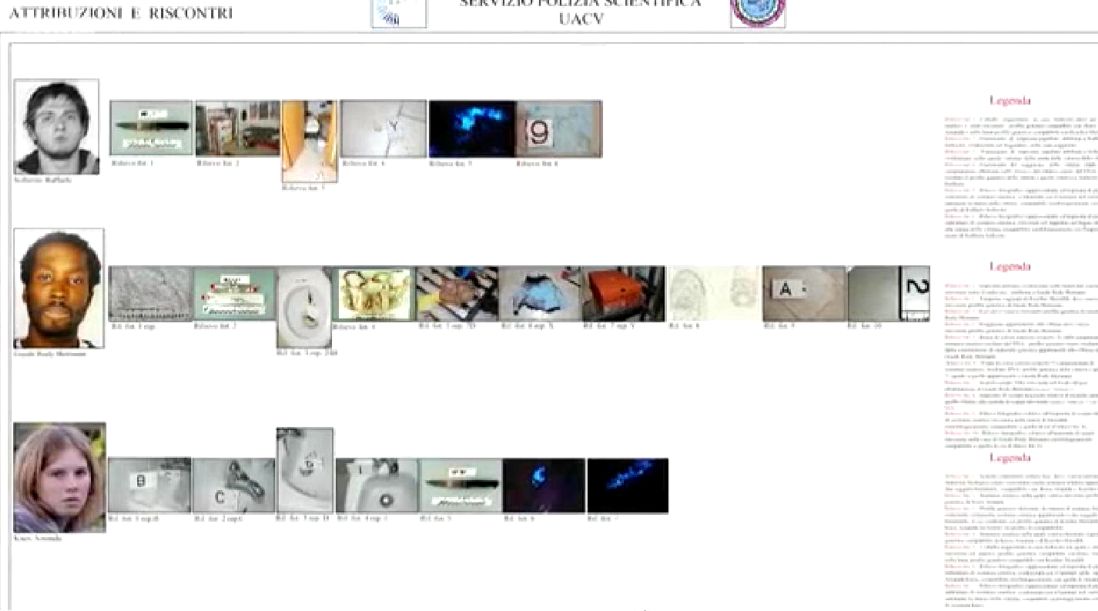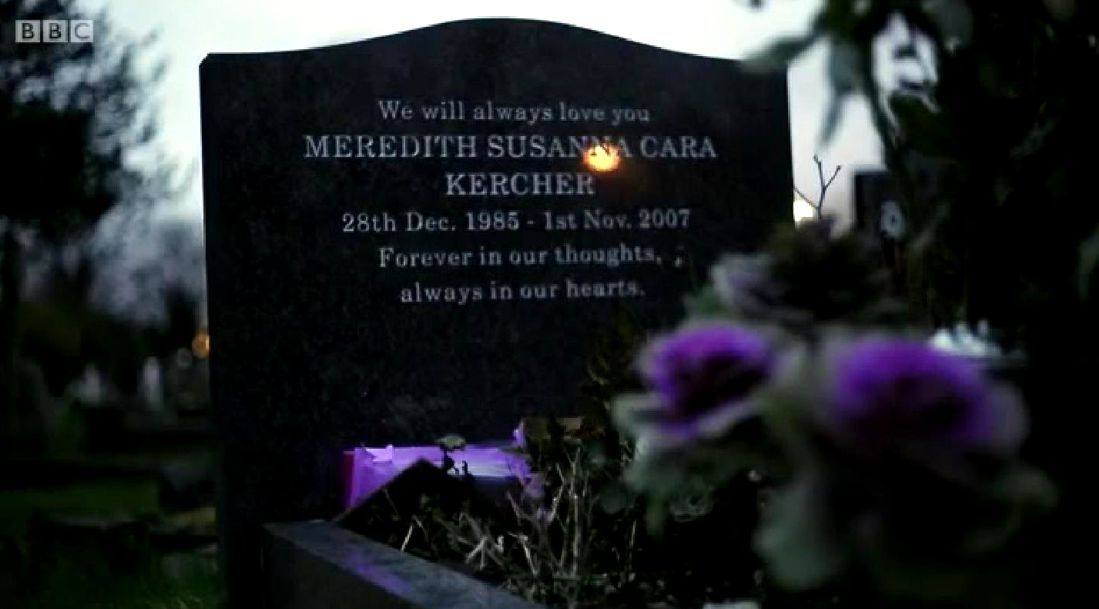
Category: Hoaxes Knox & team
Wednesday, February 19, 2014
Our Reviews Of The Painstaking BBC-3 Report First Aired In The UK On 17 February 2014
Posted by Our Main Posters
Review by SomeAlibi
Watching “Is Amanda Knox Guilty” was a funny thing. I suspect for people following the case closely, on either side, it was a sobering experience. Not because it changed perspectives, but simply to see how quickly one hour passed and the necessary trade offs that had to be made to fit within that schedule. The opportunity cost was a level of detail to which in-depth followers have become accustomed.
Just one example: Sollecito and Knox’s partial alibi that they were checking their emails on the night of November 1st was explained as being challenged by two broken computers. Perhaps, (although unlikely to be the material issue) but where was the much more salient fact that their ISP records showed that was conclusively untrue? Where was the challenge: if you say you’re checking emails to establish part of your alibi against a murder and it is shown to be absolutely untrue, what does that suggest…?
There were many other “clinchers” that had to be let go in the name of brevity. But it wasn’t that sort of documentary - it was neither a case for the prosecution or a case for the defence: it put the main suggestions at the level of detail that was possible and it allowed both sides to speak to the points at that level of detail.
I find it interesting that there has been such a howl of bias from those supporting Knox and Sollecito. Objectively there’s no good ground for it: the documentary allowed both sides forward in equal measure and no pro-justice watcher would celebrate it as a pro-conviction piece.
The arguments were balanced, the video, audio and picture quality eye-opening. For those on the other side, their markedly different reaction appears to be that the documentary has broken the taboo that The Evidence Shall Not be Told. The idea that there is an easy-to-consume piece that puts forth the case and defence equally is seen as a disaster.
The campaign for Knox continues to be obsessed, beyond all things, with trying but now failing to make sure the public doesn’t know the basis of the case. For a long time they hoped to drown out the multitude of terribly inconvenient truths within it by screaming “no evidence”. ‘Is Amanda Knox Guilty’ put the lie to that conclusively, but fairly, and now many hundreds of thousands, perhaps soon to be millions will ask themselves why those supporting Knox and Sollecito have had to adopt this tactic at all.
If they really are innocent, why has the case against them been so comprehensively white-washed in the US?
The conclusion, is rather simple and I saw it encapsulated on a large television screen last night with the repeated clips of Amanda Knox and Raffaele Sollecito outside the cottage kissing and “comforting” each other: there for a fraction of a second, shown several times, is Amanda Knox, unable to stop herself glancing at the camera filming her and stealing her gaze away again very quickly pretending she hasn’t.
It’s a look that says everything: furtive, pretending it didn’t happen, immediately covering up in a way that poses a stark proposition: why on earth would you do that if you had nothing to hide? And like so much of the multiple collapsing alibis and non-working answers and the desperately dishonest fingers-in-the-ear “no-evidence” pretence of those supporting her, is a proposition that can withstand no scrutiny.
Review by SeekingUnderstanding
What a relief to watch a very clear and unbiased narrative. The quality of the visual information was top rate - seeing so much original footage, and presented as it was in a logical time sequence.
Even though I was already familiar with the evidence, including the photographic material, I found it very helpful to see it all presented in this way. I appreciated, too, hearing and seeing the excerpts in original Italian (along with English translations). It added even more authenticity.
I hope that, at long last, this will have helped some - or hopefully many- people to see that the two ‘camps’ in this case do not divide into AK supporters and AK ‘haters’. There are the FoA and their followers ...and there are the others who seek the objective truth and justice.
If hate has been generated in some quarters, then the Knox (and Sollecito) camps need to look to themselves and their own behaviour. This programme was important in the tone it set.
I actually found it to be quite lenient towards the defence on a number of counts.
There were several instances where the defence point of view could have been strongly countered by known and established facts, but, bending over in fairness, these were left unanswered.
Here are just four instances :
1) In the discussion around the blood and DNA left in the bathroom - Dr. Gino’s assertion that ‘the blood/DNA ‘could have come from anywhere’ might have been countered with AK’s own declaration that the bathroom was previously clean. Dr. Gino also suggested a very improbable scenario of ‘it could be saliva’ (on the bidet?). Cassation emphatically said that it must be shown HOW any suggested contamination could have occurred.
2) There was a missed opportunity in discussing the knife presumed to be the murder weapon to mention Sollecito’s lame, unreal excuse of ‘Meredith pricked her hand’ etc.
3) Anne Bremner stated ‘Amanda could not have turned overnight…into a murderer’. Attention could have been drawn to many things, both physical events (her predilection for cruel pranks, including a staged burglary in the US, and wild parties, etc), and also many psychological indicators that would have clearly shown how her behaviour has, in fact, demonstrated consistency.
4) In the discussion re the bra clasp, the delay partially being caused by the defence themselves was not mentioned. Also, detailed discussion re the one bare footprint on the bathmat was omitted.
Since there is, in fact, so much evidence, it must have been difficult to chose and balance what did go into the hour long programme. All in all, I feel Andrea Vogt and her team worked hard, and did very well to let the facts speak for themselves.
I hope it will lay a few fictions and myths to rest.
Review by Earthling
What is the “Amanda Knox trial” (really the Meredith Kercher murder trial) really about? Is it about an innocent 20-year-old pretty white girl being railroaded by the medieval Italian justice system?
Or is this actually a murder trial, about the fact that a beautiful, intelligent, ambitious young woman, innocently trying to improve her life by study abroad, was brutally murdered?
I believe it’s the latter, and the BBC3 production gives us one of the first truly balanced reports on this trial.
The filmmaker starts from the beginning, and takes us through the murder, investigation, and various trials and appeals up to the present day. Instead of the breathless “Perils of Penelope” tone (toward Amanda Knox) that most such previous “documentaries” have taken, this one takes a sober look at the actual evidence.
Did you realize that there are luminol-revealed bare footprints in Knox’s size in the apartment? Luminol reveals blood and a few other substances; but those substances can be ruled out because the test was done six weeks after the murder, by which time those substances would have dissipated.
Blood doesn’t dissipate. This documentary shows you those bloody footprints in all their creepy glory, something never shown on American TV before.
“Is Amanda Knox Guilty” also speaks of the actual DNA evidence in the cottage linking Knox to the murder, including five mixed-DNA spots (Knox and Kercher) that tested positive for blood. Both prosecution- and defense-oriented experts are allowed to comment on this evidence, and the viewer is allowed to make up his or her own mind.
My one criticism is that a lot of the evidence against Knox (witness statements, cell phone data, fake break-in) is skimmed over or not even mentioned. Also, because the documentary quotes Rudy Guede’s position at length without any contradictory narrative, it is confusing as to whether the filmmaker might have believed him.
In the end, the filmmaker says, he was convicted of participating in the group murder. However, a stronger statement against his “I’m entirely innocent” defense would have been good.
Other than these quibbles, this is the best documentary on the Meredith Kercher murder case that I have ever seen.
Review by ZiaK
I watched the BBC programme on the Meredith Kercher case hoping for a more balanced view of the case than has been presented in the English-speaking media to date.
The documentary does present some of the evidence against Knox and Sollecito - including the bloody footprints, the mixed blood/DNA traces in the bathroom and corridor, the bra clasp, the knife DNA evidence, the strange timings of phone calls to police, the unlikelihood of the “break-in” being anything other than staged - but omits to point out that none of the other flatmates’ DNA was found in the blood traces, so saying that “it’s because Meredith and Amanda shared a flat” is misleading.
Nor does it point out that, although the murder knife was found in Sollecito’s flat, none of HIS DNA was found on it: it had only Amanda’s and Meredith’s DNA.
The programme didn’t cover the cell-phone evidence, showing that neither Knox nor Sollecito were where they said they were, at the times that they claimed. The programme also repeated the “Friends of Amanda” PR soundbites, such as “there was no evidence of Amanda in the murder room” - whereas the fact that her footsteps tracked blood OUT of the room are actually evidence of her having been present IN the room before it was locked (i.e. at the time of the murder).
Furthermore, in my opinion, the narrator’s voice seemed to evince sympathy towards Amanda, rather than describing events with a passive or objective tone of voice.
As one of the translators who has participated in translating case documents (such as the judges’ reports describing why they came to their decisions), I am only too aware of the extent of evidence against Knox and Sollecito, and I would like to see knowledge of this evidence become more widespread throughout the English-speaking world.
The BBC programme is a step towards this, but in my mind, only a very small step. I hope the pace will pick up soon, and more objective and extensive knowledge of the true facts of this case will be made available to everyone so they can form a rational opinion of the case based on true understanding.
Review by Cynthia
I’ve just watched this, and it’s very good - with a huge amount of footage hitherto unseen (directed by Andrea Vogt).
For what it’s worth, I note the following points:
1) There’s no mention of Meredith’s friends who heard Amanda say ‘she fucking bled to death’ before the fact was known to anyone else. Perhaps they didn’t testify, being too distressed? If so, it’s a great pity, because it seems a veritable clincher that hasn’t been used at all.
2) The bra DNA arguments are quite extraordinary. If we can determine that we all have Neanderthal DNA (tho’ I know a lot of American fundamentalists don’t believe that mankind goes back more than 6,000 years!) I can’t for the life of me see why DNA would be unusable after a poxy delay of 12 days ...
3) The argument that the Luminol traces may indicate not barefoot treading in blood but in bleach seems absolutely unbelievable to anyone who does housework (like me!) Bleach is horrible stuff, and you really, really don’t want to be getting it on your bare skin. Even Amanda, with her vestigial domestic skills, would have noticed if she’d trodden in it.
4) Bremner says Amanda was an honor student. She wasn’t; she had funded herself (not that that’s discreditable). (Also, are honor students unable to write cursive script? The shots of her handwriting show that she can’t do joined-up writing. [Or thinking.] I don’t know whether the phrase exists in American English, but not doing joined-up writing is a term of great intellectual contempt in English.)
5) We saw Amanda’s ‘mask’ speech. This is really interesting - who would even think that masks were being put on them if they weren’t using them themselves?
6) The programme mentions the little-reported fact that another, smaller knife found at Sollecito’s also had Meredith’s DNA on it.
7) The film omits to mention Hellman’s lack of any experience in criminal trials.
8) Every shot of Amanda in the film has her talking about ‘me’ and ‘I’. She never, ever mentions Meredith - it’s all about HER suffering. She never even says ‘the murderer is out there - I wish you’d stop persecuting me and get them’.
Presumably this is because Guede is supposed to be the sole murderer - and nobody seems in the slightest bit worried that there’s no murder weapon with HIS DNA on it! (Yes, there are his turds - but that wasn’t what killed Meredith.)
9) FOA has used the fact that the recent jury took 12 hours to deliberate over the verdict as an indication that they couldn’t agree. But why not just that they were being extremely careful and re-examining everything?
10) Finally, just an observation: Maresca speaks the most beautiful Italian - you can hear every word calmly flowing past.
Review by Miriam
Much appreciated. Outside of the Porta a Porta transmissions on the case, the best I’ve seen.
I understand they had to give both sides, but I felt that the defense came out on the losing side. I thought it funny that it was implied that since they only tested for blood it could of been saliva.
I don’t believe even her supporters would argue that Knox was so quirky as to brush her teeth in the bidet! Or maybe she spit in the bidet, in which case Meredith would have had every reason to complain about her bathroom habits!
Now if only this or something like this would air in the U.S.
Review by Sara
This is actually one of the most objective and well-researched reports I have seen on the case and I am very happy that BBC has managed to be so unbiased.
It presents both sides of the story equally well and does an excellent job of countering the extremely silly “no evidence” argument that the FOAkers like to repeat at equal intervals.
Regardless of what one believes, I think the documentary will at least succeed in convincing most people that there is indeed sufficient evidence against the two of them, and Italy’s judicial system is not crazy to convict people without any evidence.
My favourite part was when the defense DNA expert (can’t recall her name) tried to explain away the mixed blood evidence by saying that one of them could have had a nose bleed, and the other could have cut her hand in the same place leading to mixed blood.
Come on already, what are we? Kindergartens making excuses for not handing in homework? What is the possibility that both of them would bleed in exactly the same places not once or twice but multiple times? I think anyone with a bit of sense can see that they are clutching at straws.
However, I was a bit disappointed that few things were missed out. For instance, the fact that Guede’s footprints led straight out of the house, the fact that Amanda’s lamp was found without any obvious reason in Meredith’s room, Amanda’s extremely odd midnight call to her mom that she conveniently “forgot”, her million showers despite her concern towards “water conservation” etc.
Sollecito’s multiple changing stories were not really elaborated upon (the story in which he went to a party, the one in which he checked emails, the one in which he pricked Meredith etc etc).
Also, inconsistencies between their accounts of various events could have been pointed out (Was Filomena’s door open or close? Did AK call Filomena from the cottage or from Sollecito’s house? etc).
Witness accounts were not given any screen space either. I think touching upon these would have made the documentary even more impressive.
That said, I understand that the team has done the best they would within the limited time they had, and everything just cannot be accommodated within one hour.
So, all in all, kudos to the team and BBC for a job well done.
Review by Odysseus
I though it was a very competent overview of the case. After so much pro-defendant spin in the MSM (no doubt engineered by the American defendant’s PR outfit), it was refreshing to have a sane, measured and rational presentation. The victim deserves no less.
Congratulations to BBC3 and to the programme makers. It’s good to know that the BBC of blessed memory hasn’t been entirely dumbed-down nor intimidated by “partial outside interests”, the latter being director Andrea Vogt’s own description of the forces intent on muddying the waters in this case.
Tuesday, February 18, 2014
Congratulations To The BBC For A Report Emphasizing The Sheer Extensiveness Of The Evidence
Posted by Our Main Posters
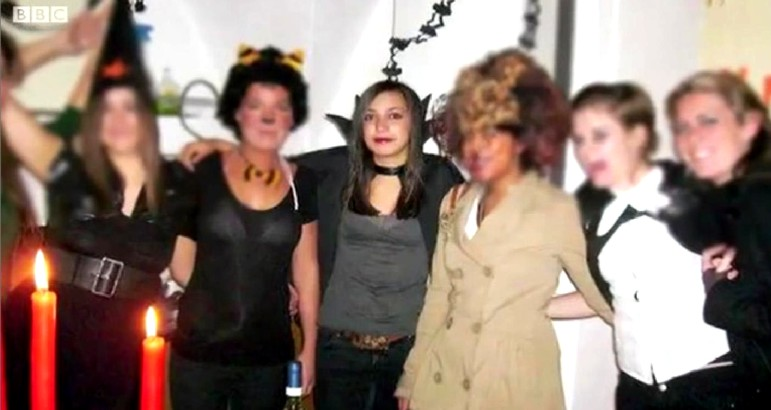
[From the BBC report: Meredith the night before the cruel, deadly attack with her Halloween friends]
This is the painstaking and obviously expensive report by Andrea Vogt and Paul Russell with interviews in London, Seattle and Perugia.
It was aired by the BBC on 17 February. Considerable time is allocated to defense lawyers and experts and the Knox family and Ann Bremner of the FOA taking their best shots at explaining how Knox could maybe have not been involved.
Still, the sheer mass of the evidence remains as the 80,000 pound elephant in the room, lacking any hint of a realistic alternative explanation. Three people committed the horrific attack, including Rudy Guede and two others.
Only Knox and Sollecito remain pointed to by dozens of evidence points as those two others. Not one single evidence point indicates anyone else was involved. The Masssei trial court got it right as the Nencini appeal court just confirmed.
We will enquire if we can embed the hour-long video. But as it may be picked up by US and other foreign media outlets, we will start by simply summarizing it soon. Assessents by those who have already seen it are welcomed.
Wednesday, February 12, 2014
Admired Feminist Victoria Brownworth On Knox As Ice-Cold And Media’s Hit & Miss Performance
Posted by Peter Quennell
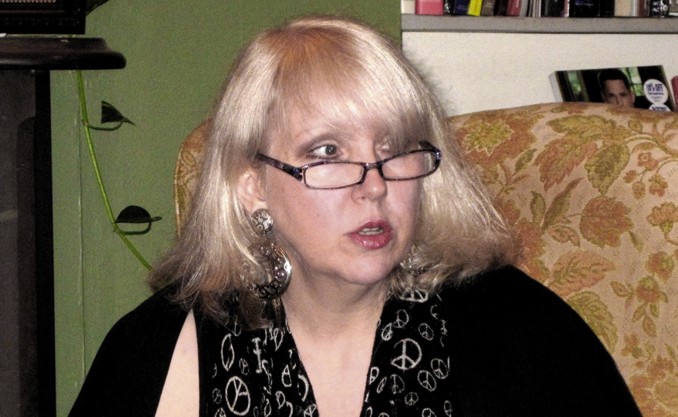
This is a key part (please read it all) from the great Victoria Brownworth’s Trial by Media - The Case of Amanda Knox
Is Knox guilty? Two long, complicated trials have said yes. Knox’s massive PR machine”“much like Simpson’s”“says no. That PR machine also ignores the fact that Knox falsely accused a black man of the murder and that he spent time in prison solely because of her accusation that she saw him take Kercher into the bedroom and heard her scream””while she, Knox, did nothing.
Angelina Antoinetti, Knox’s personal prison guard, told reporters after the conviction on Jan. 31 that Knox has reinvented herself for the media.
“Now she’s become this TV star, who cares passionately about what happened to her “˜friend’ Meredith Kercher, and wants the truth to come out. She’s painting herself as a warm, loving human being, but the Amanda I knew was so composed, I never saw her suffering and other prisoners and staff called her the Ice Maiden.”
Antoinetti said Knox “never, ever talked of Meredith or expressed emotion about her death. Whenever Meredith’s face came on TV she didn’t want to know and didn’t respond. She was impenetrable. Underneath the veneers she remains the same controlled woman I knew well in Capanne prison. She was so composed, I never saw her suffering.”
Antoinetti said that Knox “became attached to me. I opened her cell each morning and shut her in at night. She liked English music like the Beatles and always sang. She had guitar lessons, too.”
Knox was “unlike any other prisoner,” Antoinetti said. “I’ve never seen another girl like her, especially so young. She’s magnetic and manipulative. She had no emotions for people, only books. She never talked to other prisoners, she was only concerned about her world. Even when they freed her after the appeal, she didn’t speak to a single person she had just spent four years with, just walked out.
That’s not human, is it?”
And that is the question for many: Who is the real Amanda Knox?
As with the Simpson trial, the media has played a huge role in the Knox case. The U.K. papers labeled Knox “Foxy Knoxy” while the Italian papers played up Knox’s sexual history and the more lurid sexual elements of the case”“the assertion that the murder was a drug-fueled sex game gone wrong.
In the U.S. ABC News has been a virtual PR firm for Knox, devoting hours of time on both 20/20 and Good Morning America as well as the actual ABC Nightly News promoting Knox’s innocence. Diane Sawyer did a heavily promoted hour-long interview with Knox when she was released from prison in 2011. And when the Jan. 31 conviction came in, on her ABC Nightly News broadcast, Sawyer led with “the American girl” Amanda Knox”“even though Knox is 26. A full six minutes of broadcast time was devoted to Knox”“including video of her singing and playing guitar. When has a national news network treated a twice-convicted murderer in such a manner?
The two media portraits of Knox”“the sex-obsessed sexual manipulator she’s been portrayed as being by the European media and the pristine girl-next-door innocent-abroad the U.S. media has presented conflict, obviously. But what has been lost in the emphasis on Knox as the victim of the story is the actual murder victim, Meredith Kercher.
Tuesday, February 11, 2014
The Much-Demonized Rudy Guede Is Back In The News And Increasingly Threatening
Posted by Peter Quennell
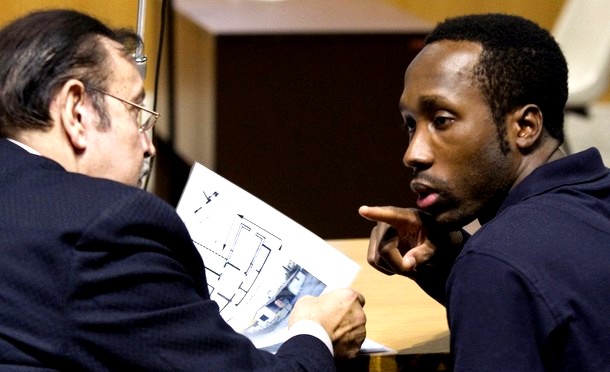
Rudy Guede has long DELIBERATELY been demonized so that the attack on Meredith can be assigned to him alone.
This description of Guede’s early days in the Ivory Coast and Perugia in the excellent Darkness Descending by Paul Russell and Graham Johnson remains the ONLY one that fully checks out. Certainly not that by the dishonest PR shill Nina Burleigh.
Guede wasn’t especially an angel, and some in Perugia were iffy about him. But he had real friends, and up north he held a real job with a real career future, until that prospect imploded and sent him haplessly back to Perugia.
Late in October 2008 Judge Micheli discounted all that Guede ever said about his role in the attack on Meredith in various conversations and statements, and sentenced Guede to 30 years.
But Judge Micheli also concluded that there was no firm evidence either that Guede acted alone or that Guede was a drifter, drug dealer, knife wielder or burglar (Micheli was very sharp with one witness who claimed Guede may - may - have broken into his house).
In 2009 through his lawyers Guede enquired of the prosecution whether he might testify at the Knox-Sollecito trial.
But the prosecutions’ hands were already tied by the indictments and they (rightly) believed they had a really strong case regardless of anything Guede could add.
At the 2009 trial the defenses pussyfooted around and never settled for a firm position on Guede. They floundered in their subdued attempts to prove that Guede or somebody else unknown was the so-called Lone Wolf.
The Lone Wolf theory is really a zombie theory with so many stakes through its heart that no court will ever take it seriously.
Guede’s steadfast fallback position before and since was that he was only in the house on the night of the attack because Meredith invited him to come in and they began love-making.
At his late-2009 first appeal and also at Sollecito’s and Knox’s 2011 appeal before Judge Hellmann, he increasingly firmly pointed the finger at Knox and Sollecito as the murderers.
Guede had been initially inclined to let sleeping dogs lie after he was mysteriously beaten up in the sex offenders wing of Viterbo prison, where prisoners are meant to be kept very safe.
But Judge Massei’s scenario of the attack on Meredith in his March 2010 Sentencing Report, with Rudy Guede as the lead instigator, really bothered him.
And in mid 2010 he became even more bothered when claims were made by a fellow prisoner the baby killer Mario Alessi that Guede confided that he really had committed the murder, along with two others. Not with Knox and Sollecito.
A very angry Rudy Guede in turn wrote a letter denying this which very rapidly went public.
In 2011 there was a tense confrontation in the Hellmann court (which several times descended into chaos) when this letter, in which by now Guede firmly accuses Knox and Sollecito, was read out for him.
Guede stuck to this position on the stand, and he was not required to face full cross-examination by the shrill, frustrated defenses because he was already convicted and no longer the one on trial.
Seemingly fed up with all the dirty tricks against him and the now-incessant Knox and Sollecito mantras in the media that Guede had acted alone, he has come out with another letter.
Italy’s AGI News Service has posted this letter to an unidentified recipient, along with this report.
(AGI) Perugia, February 11 “Against me are being repeated false imaginated reconstructions of the crime for the sole purpose of wanting to denigrate my figure and person, systematically and in a negative way, in the public eye and not just in Italy.”
He apparently also posted what he wrote in his own hand on the Facebook page “Legal processes and their surroundings”...
The letter is on a sheet of notebook paper handwritten and signed by Guede.
“To my regret I am again forced to take a pen and paper and write for the sake of the truth.. to all those thousands of people who still believe in justice.”
“They can not access all the pleadings and components of this sad and extremely complex legal case which was dramatically painful for those who lived it . My sentence and judicial reasoning have been for too long subject to a continuous and willful manipulation and alteration of the data of the proceedings.”
“Against me are made continuous false and imaginary reconstructions for the sole purpose of wanting to denigrate my figure and person, systematically and in a negative way in the public eye and not just the Italian.”
“In the final judgment, as far as I’m concerned about these false and imaginative reconstructions, is that I was acquitted of theft and simulation of crime, a fact that I never hear mentioned in the various journalistic reconstructions.”
“I also want to point out I do not accept in any way to be passed off and continually held up as a drifter, a thief, a homeless man, seeing my person and my dignity offended continually, denigrated and stereotyped by facts and things that do not realte to me… when I had a beautiful family and precious squeaky clean and friendly relations in Perugia.”
Fast-forward to today, where reports say that Guede is getting close to day-release for study purposes and may only be months away from making more evidence against Sollecito and Knox public.
Our posting lawyer TomM has looked at the issue of Guede being allowed out to study, and finds it regular and humane in this assessment.
I respect the Italian system of criminal justice. Just as I recognize that the Italian courts have much better information than anyone posting on the internet relating to the culpability of the defendants in this case, I also think that the people who oversee Guede’s stay in prison are better informed as to his fitness to be reintegrated into society. That he would be allowed out during work days to become better educated, returning to his prison cell at the end of the day seems to me a more enlightened approach than what we do here.
We used to have training programs in prisons. I don’t know that they were “cushy”, but they did work, so that when these convicts were released they were equipped with a marketable skill and rarely re-offended. But, the public thinks these were too cushy, so more Draconian circumstances and longer sentences are now the norm. It used to be people were sent to prison as punishment, now they are sent for punishment.
Sometimes when a prisoner who has spent his or her entire adult life in prison completes the sentence imposed, they have to be physically dragged from their cells, so ill-prepared are they for anything other than doing time. With no skills, social or job-related, they re-offend—surprise, surprise. Sometimes re-offense is for the purpose of being returned a world that, for all its dangers is, to them, relative safety.
While it is certainly true that prison doesn’t have much impact on sociopaths, the one thing they are attached to is money. Taking away their money does impact their behavior, so there is an alternative to killing them.
Friday, February 07, 2014
The Hubristic, Meanspirited PR Campaign: What Sort Of Life Has It Left Knox And Sollecito Now?
Posted by lauowolf
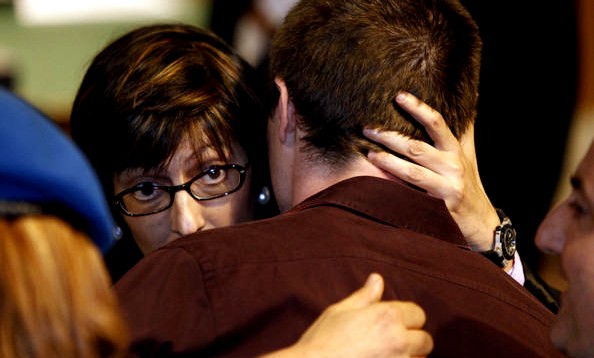
Sometimes it can be frightening to see how people’s self-interested choices turn around to bite them instead.
Had Knox and Sollecito simply told the truth to begin with, this case would have been only a nasty local story in Italy, with a bit of light coverage in Seattle and London. They would have had to accept some narrative that explained their involvement and their guilt, and they would have been sentenced accordingly.
They would then have served their time and gotten out. Eventually they would have gone on, perhaps, to live relatively normal lives.
After all, by the time they left prison virtually no one outside the families involved would remember, or much care, what they had done. Their criminal records would follow them forever, of course, but certainly there would have been no public repercussions for an obscure murder in Italy, years in the past.
People live with such pasts: they live their lives and create a future despite their pasts.
Instead, Knox and Sollecito have rendered themselves toxic for the rest of their lives. Everywhere they go, as long as they live, they will be recognized, whispered about, and pointed out by supporters, opponents, and even the relatively uniformed public.
Always.
Already, Sollecito’s Austrian side-trip was busted by someone who, predictably, recognized him. The intense paparazzi effect will eventually wear off, but years from now, whenever either of them does something simple, its effects will live on.
Apply for a library card ““ instant name recognition, walk through the airport - and someone will realize why that face is familiar. They’d better get used to it because some stranger will always recognize them. At their every life event, there will be a news alert, and someone potentially selling the story or a photo.
They and their families deliberately established an intensive PR effort for selfish reasons: in order to avoid the repercussions of a terrible act.
But this press creation is a terrible beast. Now that it is here it will need to be fed. Always. Get drunk in public - someone will have a cell phone handy; a marriage breaks up - the ex-spouse will tell all. (And, really, neither of them has the kind of money needed to live forever insulated from the vulgar public.)
For the rest of their lives, in everything they want to do, the whole did-they-or-didn’t-they narrative will be weighed in other people’s reaction: Would you hire either of them for anything? Would you rent them an apartment? Elect them to the school board?
All other things being equal, there will always be someone else available, someone equally good who has no awkward history. And everyone will know about that history; they worked hard to make it so.
And I’m not talking about the prejudice against ex-cons. That’s a real thing, and it will have its impact too. All convicted felons have real problems, after all, but few of them have achieved such notoriety, let alone embraced it. What I’m talking about is the impact of even old-news celebrity, of always now, and for the rest of their lives, being tabloid fodder.
Sure, there will always be people (Mad Pax?) drawn to the faux glitter of it all, but a life accompanied only by those wanting to share in your “fame” seems pretty ugly to me. What normal person wants the hassle of becoming involved with something like this?
Furthermore, they will never know when someone they think of as a friend might suddenly start thinking of a way to cash in. There might be a book in it, or at least a juicy article for a tabloid.
This isn’t meant as expressing any kind of sympathy for them at all, by the way. They have blood on their hands and horrors in their heads.
Eventually they may come to some kind of terms with their actions. Frankly, though, I hardly care, for it is not merely their crime that requires expiation. I have been sickened to see the unfolding ruthlessness and the sheer ugliness of their publicity campaign.
At its center their PR beast reveals an utter selfishness that is willing to appeal to the worst in their supporter through appeals to American xenophobia, to racism, and in smears against Meredith, Rudy, and Patrick, as well as the entire system of Italian justice.
The PR beast they created denigrates every other element in the case, while portraying the pair of them as young, innocent, and only guilty of a visible passion for each other and a naïve belief in the police.
This tactic required a media product for sale: the attractive young lovers. Their campaign has forced their names, and images and story in all our faces for years now. They and their families did this entirely voluntarily, and they have seemed to relish the attention it brought them.
They’ve been interviewed extensively, treated sympathetically by those who should know better, and altogether have had much more than their fifteen minutes of fame. But celebrity is a beast that turns on its own.
And, importantly, unlike other famous people ““ actors, politicians, authors and the like - there is no proper use for their fame. They have nothing real to share with us, only their story. It is, literally, all about them. And that is how it will remain.
They have become a narrative whose next chapter will always be told. The PR beast, for all its reach, will not be enough to keep them out of prison. But the cameras will be there the day they finally leave prison, in case we have forgotten their faces.
And there will be photos when they drive drunk. Or marry. Or divorce.
Their names are out there, waiting for the tagline, waiting for the joke. (“How bad is your new roommate? Well, at least she’s no Amanda Knox.”) There will be no end to it, ever. They will have no privacy, ever. Karma at work is a scary thing. They invited the beast into their lives, and now it will never leave them alone.
[Below: Said to be Amanda Knox leaving home hiding under a windcheater]
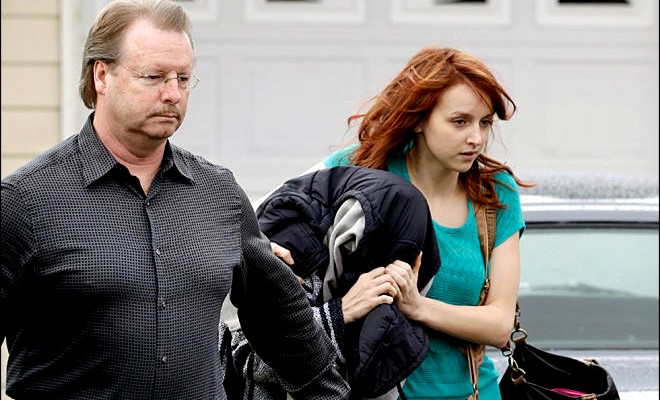
Monday, February 03, 2014
Guide For Smart Media: Note Extensive Hard Evidence In Exceptionally Fair, Careful Legal Process
Posted by Media Watcher
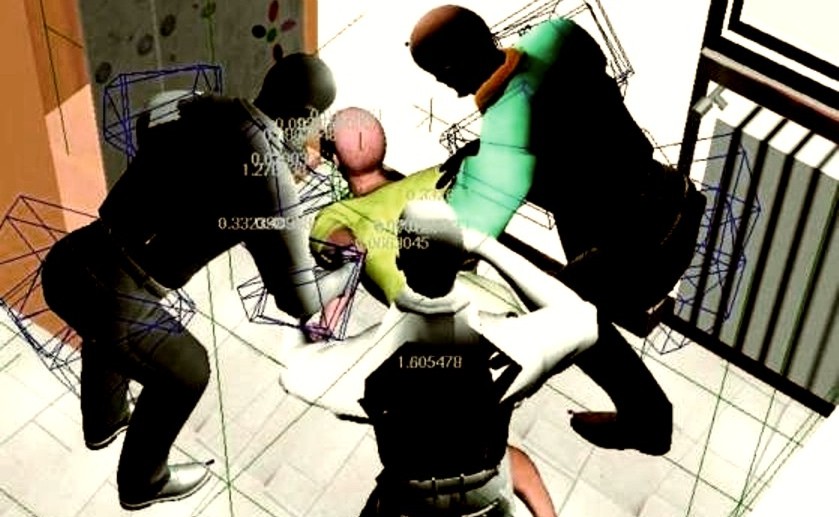
[Accurate Italian media recreation of attack based on masses of closed court evidence 2009]
Vital media history in 2009
In Italy and Europe generally the guilt of the two is almost universally perceived.
One reason is that although about 1/4 of the trial in 2009 was behind closed doors (quite the opposite of the “tabloid storm” and “show trial” Americans have been told about) Italians in particular got to find out about the long (15 minutes), remorseless, highly sadistic attack on Meredith.
Please click here for more
Friday, January 10, 2014
Amanda Knox Confirms She Faked A Break-In in Seattle Long A Sore Point To Previous Victims
Posted by Peter Quennell

[Knox’s off-campus house shared with others near the University of Washington]
It was an open secret in November 2007 among those who had known Knox in Seattle that her charge for murder did not exactly surprise everybody.
“That figures” was in effect their take.
We got to hear about boozing and drug-use. Also (see here and here) about deep anger issues in the Knox-Mellas family, and also about Knox writings (scroll down here to “Baby Blue”) in which violence and cruelty appeared front and center.
We got to hear the hard facts about the rock-throwing abuse of neighbors and passing cars in the course of a drug-fueled party in which Knox was probably lucky to be charged only with a misdemeanour.
And we got to hear rumors, but no hard confirmation, about a faked break-in near the University of Washington campus, in which Knox apparently exulted while those hoaxed were left pretty shaken.
Nobody else ever reported that they found it at all funny, but Knox herself has now off-handedly laughed it off on her increasingly bizarre and telling website. Steven Wentworth has an excellent commentary on TEKJournalismUK. It is all worth reading. These are key excerpts:
She admitted that the hazing prank, played on her flat-mates at the University of Washington, involved messing up the flat and hiding things to make it appear as if items had been stolen. Knox used “mutual friends” of her other housemates to help fake the burglary in her own premises. She acknowledges that it caused “distress” to her housemates and she and her accomplices had to apologise for the act…
Rumours of the hazing prank have been around for years, after a former acquaintance of Knox’s let the story slip, just a month after her arrest. On being pressed for details, the informant clammed up, and the incident has subsequently been vociferously denied by members of Knox’s family and her supporters. Meanwhile her defence have made repeated references to Rudy Guede’s past actions as character evidence against him.
Yesterday’s revelations will come as no surprise to case-watchers. Her decision to stay away from the appeal hearing in Florence was widely seen as an “˜own goal’, and her emailed plea to the court clearly irritated the judge. In it, she suggested that the court would be unable to remain neutral in deciding her fate ““ a move not designed to curry favour with the judiciary. Whether her latest admission makes an impact on the current hearing remains to be seen.
And then according to her own words based on a huge lie to her parents and others in her circle in Seattle, this loose cannon headed for Europe, with little structure, little money, and little intention to do any serious study. In reality she was taking a year off.
Everybody she came in contact with there was well-meaning, hard-working and acting responsibility. By all accounts except her own, she then in sharp contrast evolved into a grating unhygienic nuisance who made few friends, and soon lost all but that oddball Sollecito. Even he she described as soon shrugging off.
Knox is already being remarked upon in Italy as “too cowardly” to turn up at what is in fact HER appeal and have to face all of those she has been smearing. Her ill-advised blog is being observed and could result in yet another obstruction of justice charge as it rarely strays too close to the truth.
Way to go to ensure a stiff sentence? Probably this time with zero mitigating factors.
Wednesday, December 18, 2013
Demonizations By Knox: Multiple Ways In Which Her Email To Judge Nencini Is Misleading
Posted by FinnMacCool
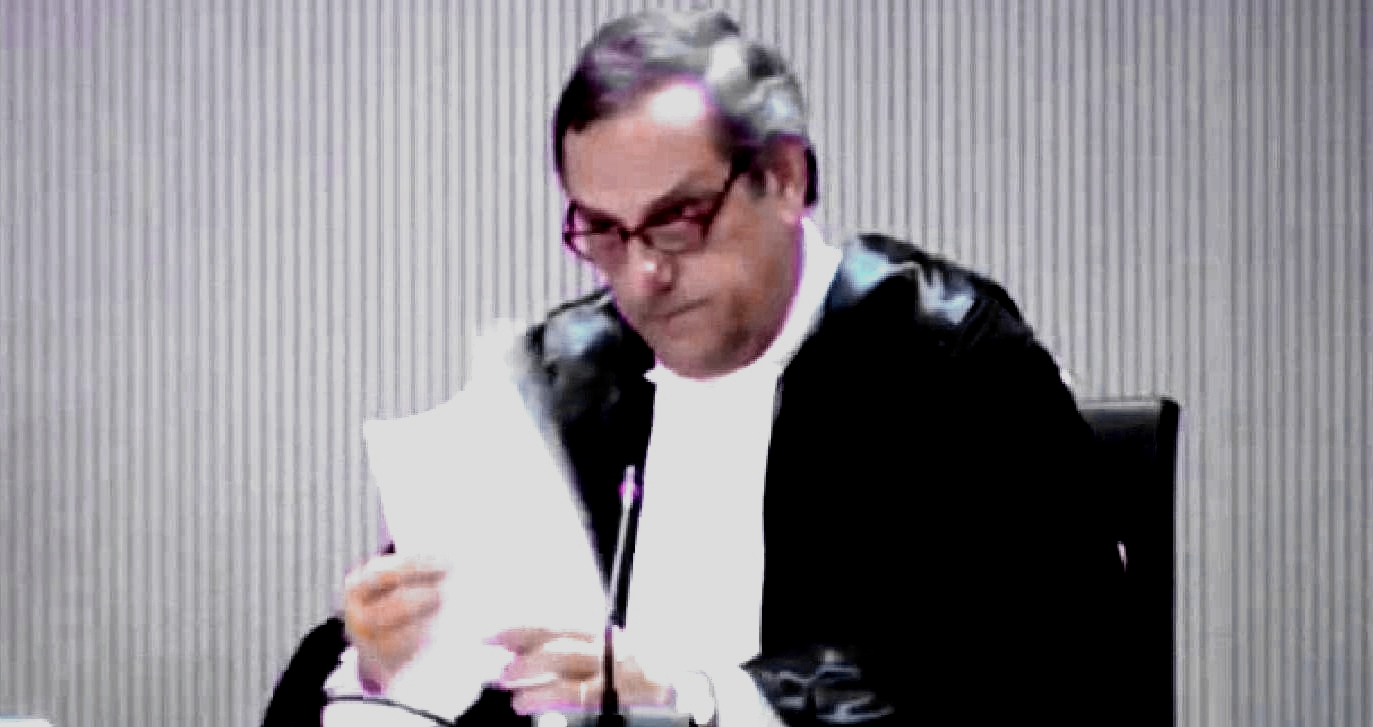
You can read here the email Amanda Knox sent to Judge Nencini.
It is dated 15 December 2013 and was handed to Dr Nencini by Dr Ghirga, apparently to the disdain of both of them. It contains many statements which, if she were under oath, could be considered perjury.
One telling point is that she claims “I am not present in the courtroom because I am afraid.” Her co-defendant, Raffaele Sollecito, was not at all afraid of being at their own appeal, and he did present himself at an earlier stage of the proceedings.
He made a spontaneous statement and the judge assured him that he should feel free to intervene to make further interventions whenever he wished. So far he hasn’t wished to - he preferred to head back to the Caribbean for his holiday.
But that event and that presence by Sollecito completely undermine the credibility of Knox’s claim that she feels afraid of the court proceedings. As it is her own appeal, there would be nothing to stop her coming and going, at any stage, just as Sollecito did.
I have no doubt that my lawyers have explained and demonstrated the important facts of this case that prove my innocence and discredit the unjustified accusations of the prosecution and civil parties.
That’s what her lawyers were about to try to do. But instead they had to hand this email to the judge, showing their client’s complete contempt for the court process.
I seek not to supplant their work
She doesn’t want to supplant the work of her own lawyers? Most defendants don’t, nor do they feel the need to tell the court that using an archaic seventeenth-century grammatical construction (where modern English would have “I do not mean to…” or “I do not wish to”).
Because I am not present to take part in [my own appeal], I feel compelled to share.
As Judge Nencini said, if anyone wants to talk to a court, come to that court. Knox chose not to be present, which means that the word “because” is not a logical connector for why she feels compelled to share what she thinks. “Even though” would make more sense.
The Court has access to my previous declarations and I trust will review them…
The court has access to thousands of pages. Everybody trusts that courts will review the evidence before passing judgment - that’s how the legal process works.
I must repeat: I am innocent.
In fact, she does not have to repeat that, which is simply a reiteration of her not-guilty plea.
I am not present in the courtroom because I am afraid.
The wording is reminiscent of a previous declaration, “I am very afraid of Patrik, the African boy who…” Also the court may remember the presence of her co-defendant, who made a brief presentation to the court (and was invited to intervene again at any time he saw fit) and who afterwards flew back to his extended vacation in the Dominican Republic. It is difficult to see what the defendants have to be afraid of from the court - except perhaps the truth.
I am afraid that the prosecution’s vehemence will leave an impression on you, that their smoke and mirrors will blind you.
The prosecution’s case has already been made; this was the opportunity for the defense to make their case. It is the court’s duty to consider the evidence without being overly swayed by the vehemence of lawyers from either side - they look at the facts, and pass judgment based on that, and this happens in literally millions of cases every year. (Cassazione alone reviews more than 80 thousand cases each year.)
This is not for lack of faith in your powers of discernment, but because the prosecution has succeeded before in convincing a perfectly sound court of concerned and discerning adults to convict innocent people - Raffaele and me.
The second half of the sentence contradicts the first. The writer is explicitly stating that she doubts that the court has sufficient powers of discernment to be able to see through the prosecution’s arguments. Her justification for saying this is simply that it has happened before, with a previous court.
I’ve attentively followed this process and gleaned the following facts…
This is a delusional statement. The writer is the appellant, the initiator of the process, not an external observer to it. We can compare it with her statements following her arrest, in which she claimed still to be helping the police on an equal basis with them, despite being charged with the murder.
No physical evidence places me in Meredith’s bedroom, the scene of the crime…
The bedroom is where the murder took place, but the crime scene is much wider than that, and certainly encompasses the adjoining room where the burglary was faked, the bathroom where the killers cleaned up, and the corridor that connects those rooms. Knox’s blood, DNA, bare footprints are all found in those places. Within Meredith’s room itself, there is also a woman’s shoeprint that does not match the victim, and which Knox’s own lawyer was obliged to claim was caused by an unfortunate fold in the pillowcase.
Meredith’s murderer left ample evidence in the brutal scenario: handprints, footprints, shoe prints in Meredith’s blood, DNA in her purse, on her clothing, in her body.
The term “brutal scenario” makes no sense here, although she repeats it again a couple of lines later. Perhaps she means “crime scene” or “bedroom”. The only footprints found at the crime scene are those of Knox and Sollecito. A woman’s shoeprint in the room where the murder took place cannot be that of either Guede or the victim, and is most likely that of Knox.
The prosecution has failed to explain how I could have… been the one to fatally wound Meredith ““ without leaving any genetic trace of myself. That is because it is impossible.
Actually it is perfectly possible to do this ““ for example, simply by stabbing someone to death while wearing gloves. However, in this case the prosecution has in fact explained how several traces of Knox’s DNA have been found on the handle of the knife which had the victim’s DNA on the blade. That obviously fits a scenario in which Knox stabbed Meredith Kercher with that knife.
Either I was there, or I wasn’t.
The same thing applies to the appeal court. Either the defendants are there, or they are not. In this case, the defendant is not.
The analysis of the crime scene answers this question: I wasn’t there.
Knox’s footprints, blood and DNA, sometimes mixed with that of the victim, all place her at the crime scene, and so does her DNA on the handle of the murder weapon.
My interrogation was illegal and produced a false “confession” that demonstrated my non-knowledge of the crime.
“Non-knowledge” is a curious word. Knox’s witness interview was perfectly legal ““ it was only the unexpected confession from the witness that changed the status of that interview, so that its contents could no longer be used against her. But there is no question over its legality.
The subsequent memoriali, for which I was wrongfully found guilty of slander…
This is an extraordinary aside. The defendant is here rejecting the legitimacy of the Italian Supreme Court, which has definitively found against her, and is also rejecting the findings of the Hellmann court that provisionally freed her, pending appeal. Every single court has found against her on this count.
. ...did not further accuse but rather recanted that false “confession”.
Let us reread some excerpts from this supposed recantation: “After dinner I noticed there was blood on Raffaele’s hand… I stand by my statements that I made last night about events that could have taken place in my home with Patrik… In these flashbacks I’m having, I see Patrik as the murderer…Why did I think of Patrik?... Is there any other evidence condemning Patrik or any other person?” This is not a recantation, and it does in fact contain further accusations of Patrick Lumumba while also seeking to throw suspicion both on Sollecito and an unnamed “other person”.
My behavior after the discovery of the murder indicates my innocence.
As dozens of witnesses have testified in a series of trials and appeals, Knox’s post-murder behavior indicated the exact opposite, which is why suspicion fell on her in the first place.
I did not flee Italy when I had the chance.
On page 71 of her memoir, Knox recounts the following exchange with Officer Ficarra, on the day after the murder was discovered: “My parents want me to go to Germany to stay with relatives for a couple of weeks. Is that okay?” She said, “You can’t leave Perugia. You’re an important part of the investigation.”
I stayed in Perugia and was at the police’s beck and call for over 50 hours in four days.
Chapter Ten of her memoir gives her own account of what she did on Monday, November 5th. She went to a nine o’clock grammar class, at which she refused to discuss the case with her fellow students; she spoke on the phone with her Aunt Dolly, admitting that she had not yet contacted the US embassy; she bumped into Patrick Lumumba where she refused to talk to BBC reporters; she spent the afternoon with Sollecito and then accompanied him to a friend’s house where she played the ukulele. Far from being at the police’s beck and call, she ignored their request that she stay home while they interview Sollecito separately, and turned up to the Questura regardless, although not before they had finished their evening meal.
The police coerced me into signing a false “confession””¦.
Her false accusation of Patrick Lumumba, for which she was convicted and has already served four years in prison, was not a confession and was not coerced.
. “¦one may be coerced into giving a false “confession” because of psychological torture”¦ This is a universal problem.
The US-based Innocence Project reports that there have been 244 exonerations since 2000, which is just over seventeen per year, which in turn means that currently in the USA, roughly 0.1% of cases are eventually overturned. Being wrongfully convicted might be devastating for the person concerned, but it is not a universal problem.
I did not carry around Raffaele’s kitchen knife.
The defendant has not been accused of carrying the knife around, but rather of stabbing Meredith Kercher to death with it. Forensic evidence supports that accusation, too.
I had no contact with Rudy Guede. Like many youth in Perugia, I had once crossed paths with Rudy Guede.
Very typical of Knox’s writing is this kind of self-contradiction, sometimes occurring within the same sentence, or as in this case, in consecutive sentences, seemingly with no self-awareness that any contradiction has even occurred.
If the prosecution truly had a case against me, there would be no need for these theatrics.
The prosecution is present in the court, having made its presentation in the usual way. The defense lawyers are about to do exactly the same thing. The only theatrics happening in the court at that moment is a bizarre email sent by one of the defendants, in lieu of attending her own appeal to her own murder conviction.
But because no evidence exists that proves my guilt, the prosecution would seek to deceive you with these impassioned, but completely inaccurate and unjustified pronouncements.
No further comments.
Tuesday, December 17, 2013
Appeal Session #7: The Day For Knox And Sollecito Attorneys To Show Where Prosecution Went Wrong
Posted by Our Main Posters
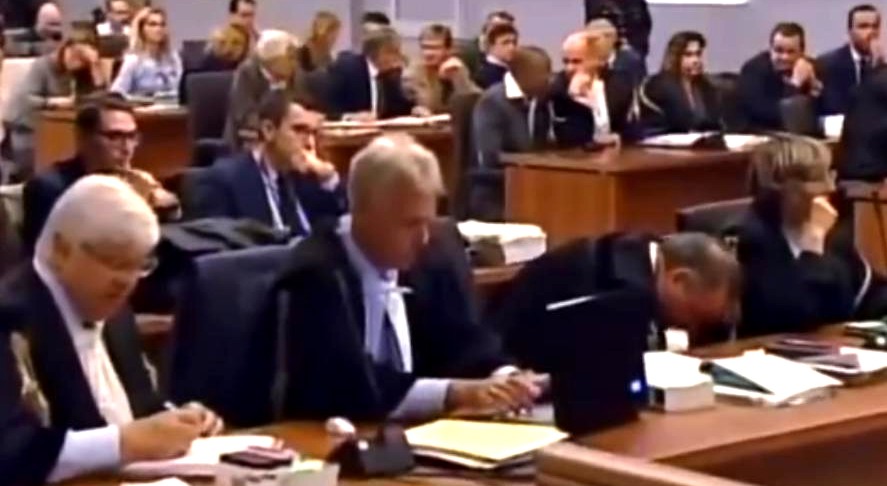
[Above and below: images from previous sessions, here till today’s crop appears]
Long Form Reports
The court hearing reserved for Knox’s appeal defense began with the reading of an email from Amanda, reported here in the Messaggero and then widely picked up in the English-language press, claiming her innocence and explaining why she was afraid to return to Italy. The email was the only “new” aspect introduced Tuesday so made all the headlines, but at the end of the day it occupied just a small fraction of the day’s arguments.
Several Italian court observers considered the email a considerable “own goal,” having witnessed the presiding judge raise his eyebrows in obvious annoyance at having to himself read aloud an email from Knox, who requested an appeal in his courtroom, but is refusing to attend it, for reasons she detailed. “Those who want to speak at the trial should come to the trial,” he said. He also declined to consider the letter a spontaneous declaration because, he said, he could not ascertain if she was the true author of the letter. “I’ve never seen her. I do not know her,” he said.
After the email, Knox’s Perugian lawyer Luciano Ghirga made his closing arguments, followed by Carlo Dalla Vedova of Rome. Most of the discussion focused on two aspects of the case they felt are fundamentally lacking: motive and murder weapon. Below are short quotes/snippets translated quickly during court. To read the Kercher family lawyer’s arguments, scroll down to yesterday’s notes.
[Report continues on The Freelance Desk with good summaries of arguments made by Ghirga and Della Vedova]
3. Tweets from La Nazione
66. Meredith process , the hearing ends. The next hearing will be on January 9 [Sollecito team]
65. Lawyer Dalla Vedova (Knox) : ” Amanda Knox is shown to have worshipped [Meredith]”
64. Lawyer Dalla Vedova (Knox) : “There is a shortage of proof”
63. Lawyer Dalla Vedova (Knox) : “There is no evidence, with doubts you have to acquit Amanda Knox”
62. Lawyer Dalla Vedova (Knox) : “On the motive the prosecutor did the same as the Costa Concordia at Giglio”
61. Lawyer Dalla Vedova (Knox) : “Room too small for the participation of more people in the crime”
60. Lawyer Dalla Vedova (Knox) : “The victim was attacked from the front, not from behind”
59. Lawyer Dalla Vedova (Knox) : “For Amanda and Raffaele, Rudy Guede was a stranger”
58. Lawyer Dalla Vedova (Knox) : “The bra clasp of Meredith is not a genuine artifact”
57. Lawyer Dalla Vedova (Knox) : “The bra clasp November 2nd was white, but 40 days after gray”
56. Lawyer Dalla Vedova (Knox) : “Amanda knew the cut was throat because she was told by a policeman “
55. Lawyer Dalla Vedova (Knox) : “Absurd that there are missing only traces of Amanda and Raffaele “
54.Lawyer Dalla Vedova (Knox) : “The alleged footprint of female shoe on the pillow: pillowcase was folded over.”
53. Lawyer Dalla Vedova (Knox) : “The broken glass from the window shows the easiest way to enter the house “
52. Lawyer Dalla Vedova (Knox) : “War between consultants is like “The War of the Roses” where everyone will hate “
51. Lawyer Dalla Vedova (Knox) : “Unable for Amanda and Raffaele to commit the crime in 50 minutes “
50. Lawyer Dalla Vedova (Knox) : “The mother of Meredith says she and Amanda were friends “
49. Lawyer Dalla Vedova (Knox) : “Guede never says that Amanda was in the house, even outside the interrogations”
48. Lawyer Dalla Vedova (Knox) : “Guede never talks about Amanda “
47.Lawyer Dalla Vedova (Knox) : ” Guede in his chats after the murder told a friend that Amanda had nothing to do with it”
46. Lawyer Dalla Vedova (Knox) : “There are traces only of Rudy Guede at the crime scene “
45. Lawyer Dalla Vedova (Knox) : “The witness Curatolo either is unreliable or is our alibi. Decide for yourself “
44. Lawyer Dalla Vedova (Knox) : “Do not trust the testimony of the witness Quintavalle “
43. Lawyer Dalla Vedova (Knox): “Amanda did not call into question Lumumba to sidetrack the investigation “
42. Lawyer Dalla Vedova (Knox): “The alibi of Amanda is of the same type as her roommates ”
41. Lawyer Dalla Vedova (Knox): “The alibi of Amanda is accurate and unchanged in her deposition ”
40. Meredith appeal: the argument of Carlo Dalla Vedova, defender of Amanda Knox, resumes.
39. Meredith appeal: Judge orders one-hour lunch break
38. President Nencini asks if there are certificates for the AIDS tests done on Amanda, but there are none
37. Lawyer Dalla Vedova (Knox): “It was said of Amanda in prison that she had AIDS, but it turned out an error ”
36. Lawyer Dalla Vedova (Knox): “From the conversations in prison Amanda does not show anything, the sum of zeros ”
35. Lawyer Dalla Vedova (Knox): “In 30 hours of interviews with parents in prison Amanda never was heard [incriminating herself]”
34. Lawyer Dalla Vedova (Knox): “It was immediately admited, the mistake by the investigators”
33. Lawyer Dalla Vedova (Knox): “The footprint of Guede on the pillow right now is the signature of the crime”
32. Lawyer Dalla Vedova (Knox): “Lumumba was not to be charged, he confirmed his alibi”.
31. Lawyer Dalla Vedova (Knox): “There has been judicial harassment against [my client]”
30. Lawyer Dalla Vedova (Knox): “Prosecution and plaintiff leverage statements of Amanda unusable ”
29. Lawyer Dalla Vedova (Knox): “The declarations of Amanda between 5 and 6 November are unusable ”
28. Lawyer Dalla Vedova (Knox): “Absurd that Amanda is joining the attack on a friend ”
27. Lawyer Dalla Vedova (Knox): “Changing motive is constantly an element of weakness of the prosecution ”
26. Lawyer Dalla Vedova: “Add up all the clues , the sum of zero is always zero ”
25. Lawyer Dalla Vedova: “Without connections between clues and evidences the value is zero ”
24. Lawyer Dalla Vedova: “In this process there is no evidence ”
23. Lawyer Dalla Vedova: “A murder without a motive is fallacious ”
22. Lawyer Dalla Vedova: “Absurd that the knife used for the murder was brought home ”
21. Lawyer Dalla Vedova: “Imaginative reconstruction of the prosecution ”
20. Lawyer Dalla Vedova: “This story has been in the headlines for months ”
19. Lawyer Dalla Vedova (Knox): “Meredith killed in this manner is a defeat for all ”
18. The closing argument of Lawyer Carlo Dalla Vedova begins (Knox defense).
17. Meredith appeal: the closing argument of the Lawyer Ghirga (Knox ) ends.
16. Lawyer Ghirga (Knox ) : “Amanda Knox was not present at the crime scene ”
15. Lawyer Ghirga (Knox ): “The judgment of Justice is the acquittal of Amanda
14. Lawyer Ghirga (Knox ): “The witness Curatolo is unreliable ”
13. Lawyer Ghirga (Knox ): “We challenged from the outset the murder weapon ”
12. Lawyer Ghirga (Knox ): “On the blade of the knife there is no blood and no trace of Meredith.”
11. Lawyer Ghirga (Knox ): “The expertise that revealed traces of Meredith on the knife is not trusted “
10. Lawyer Ghirga (Knox ): “The knife found at Sollecito’s house is not the murder weapon “
9. The closing argument of Luciano Ghirga defender Amanda Knox begins.
8. Amanda to the court: ” I am innocent , put an end to this enormous injustice ”
7. Amanda : “I’m not the monster he has been portrayed in recent years ”
6. Amanda: ” I did not know Rudy Guede ”
5. Amanda: “I’m not a killer , the prosecution and the civil parties are wrong , they want a conviction without proof ”
4. Amanda: ” Meredith and I have always been friends , we never quarreled ”
3. Amanda: “I have been subjected to illegal interrogation , I made a false confession extorted”
2. Amanda: “I have not killed , raped , robbed , I was not at the scene of the crime”
1. The email of Amanda : “I’m innocent , but I am not in court because I’m afraid”
2. Tweets from Freelance Andrea Vogt
3. Carlo dalla Vedova to #amandaknox appeal jury: If there is no murder motive, you must acquit.
2. Carlo dalla Vedova: We know #amandaknox is innocent. As time passes we’re even more tranquil.There are many more doubts than certainties.
1. In Florence, amanda knox lawyer holds up large knife to jury: “Starch was on the knife. It was not cleaned. It was in domestic use.”
1. Email from Amanda Knox
Court of Appeals of Florence section II Assise Proc. Pen, 11113
Letter sent to attorneys Carlo Dalla Vedova and Luciano Ghirga via email Seattle, 15 December 2013
Attn: Honorable Court of Appeals of Florence
I have no doubt that my lawyers have explained and demonstrated the important facts of this case that prove my innocence and discredit the unjustified accusations of the prosecution and civil parties. I seek not to supplant their work; rather, because I am not present to take part in this current phase of the judicial process, I feel compelled to share my own perspective as a six—year-long defendant and victim of injustice.
The Court has access to my previous declarations and I trust will review them before coming to a verdict. I must repeat: I am innocent.
I am not a murderer. I am not a rapist. I am not a thief or a plotter or an instigator. I did not kill Meredith or take part in her murder or have any prior or special knowledge of what occurred that night. I was not there and had nothing to do with it.
I am not present in the courtroom because I am afraid. I am afraid that the prosecution’s vehemence will leave an impression on you, that their smoke and mirrors will blind you. I’m afraid of the universal problem of wrongful conviction. This is not for lack of faith in your powers of discernment, but because the prosecution has succeeded before in convincing a perfectly sound court of concerned and discerning adults to convict innocent people-Rafael and me.
My life being on the line and having with others already suffered too much, I’ve attentively followed this process and gleaned the following facts that have emerged from the development of this case that I beg you not to dismiss when making your judgment:
No physical evidence places me in Meredith ‘s bedroom, the scene of the crime, because I was not there and didn’t take part in the crime.
Meredith’s murderer left ample evidence of his presence in the brutal scenario: handprints, footprints, shoe prints in Meredith’s blood; DNA in her purse, on her clothing, in her body.
No evidence places me in the same brutal scenario. The prosecution has failed to explain how I could have participated in the aggression and murder—to have been the one to fatally wound Meredith—without leaving any genetic trace of myself. That is because it is impossible. It is impossible to identify and destroy all genetic traces of myself in a crime
scene and retain all genetic traces of another individual. Either I was there, or I wasn’t. The analysis of the crime scene answers this question: I wasn’t there.
My interrogation was illegal and produced a false “confession” that demonstrated my non-knowledge of the crime- The subsequent memoriali, for which I was wrongfully found guilty of slander, did not further accuse but rather recanted that false “confession.” Just as I testified to the prosecutor in prison and to my family members in prison when our conversations were being recorded without my knowledge.
My behavior after the discovery of the murder indicates my innocence. I did not flee Italy when I had the chance. I stayed in Perugia and was at the police’s beck and call for over 50hours in four days, convinced that I could help them find the murderer. I never thought or imagined that they would have used my openness and trust to fuel their suspicions. I did not hide myself or my feelings: when I needed comfort, Rafael embraced me; when I was sad and scared, I cried; when I was angry, I swore and made insensitive remarks; when I was shocked, I paced or sat in silence; when I was trying to help, I answered questions, consoled Meredith’s friends and tried to keep a positive attitude.
Upon entering the questura I had no understanding of my legal position. Twenty—years old and alone in a foreign country, I was innocent and never expected to be suspected and subjugated to torture. I was interrogated as a suspect, but told I was a witness. I was questioned for a prolonged period in the middle of the night and in Italian, a language I barely knew. I was denied legal counsel- The Court of Cassation deemed the interrogation and the statements produced from it illegal. I was lied to, yelled at, threatened, slapped twice on the back of the head. I was told I had witnessed the murder and was suffering from amnesia. I was told that if I didn’t succeed in remembering what happened to Meredith that night I would never see my family again. I was browbeaten into confusion and despair. When you berate, intimidate, lie to, threaten, confuse, and coerce someone in believing they are wrong, you are not going to find the truth.
The police coerced me into signing a false “confession” that was without sense and should never have been considered a legitimate investigative lead. In this fragmentary and confused statement the police identified Patrick Lumumba as the murderer because we had exchanged text messages, the meaning of which the police wrongfully interpreted (‘Civediamo piu tardi. Buona serata’). The statement lacked a clear sequence of events, corroboration with any physical evidence, and fundamental information like: how and why the murder took place, if anyone else was present or involved, what happened afterward—it supplied partial, contradictory information and as the investigators would discover a little later, when Patrick Lumumba’s defense lawyer produced proof of him incontestable alibi, it was obviously inaccurate and unreliable. I simply didn’t know what they were demanding me to know. After over 50 hours of questioning over four days, I was mentally exhausted and I was confused.
This coerced and illegitimate statement was used by the police to arrest and detain a clearly innocent man with an iron-clad alibi with whom I had a friendly professional relationship. This coerced and illegitimate statement was used to convict me of slander. The prosecution and civil parties would have you believe that this coerced and illegitimate statement is proof of my involvement in the murder. They are accusing and blaming me, a result of their own overreaching.
Experience, case studies, and the law recognize that one may be coerced into giving a false"confession” because of torture.
This is a universal problem. According to the National Registry of Exoneration, in the United States 78% of wrongful murder convictions that are eventually overturned because of exonerating forensic evidence involved false “confessions.” Almost 8 in 10 wrongfully convicted persons were coerced by police into implicating themselves and others in murder. I am not alone. And exonerating forensic evidence is often as simple as no trace of the wrongfully convicted person at the scene of the crime, but rather the genetic and forensic traces of a different guilty party—just like every piece of forensic evidence identifies not me, but Rudy Guide.
In the brief time Meredith and I were roommates and friends we never fought.
Meredith was my friend. She was kind to me, helpful, generous, fun. She never criticized me. She never gave me so much as a dirty look.
But the prosecution claims that a rift was created between Meredith and I because of cleanliness. This is a distortion of the facts. Please refer to the testimonies of my housemaster and Meredith’s British friends. None of them ever witnessed or heard about Meredith and I fighting, arguing, disliking each other. None of them ever claimed Meredith was a confrontational clean-freak, or I a confrontational slob. Laura Masotho testified that both Meredith and I only occasionally cleaned, whereas she and Filomena Romanelli were more concerned with cleanliness. Meredith’s British friends testified that Meredith had once told them that she felt a little uncomfortable about finding the right words to kindly talk tome, her new roommate, about cleanliness in the bathroom we shared. The prosecution would have you believe this is motivation for murder. But this is a terrifying distortion of the facts.
I did not carry around Rafael’s kitchen knife.This claim by the prosecution, crucial to their theory, is uncorroborated by any physical evidence or witness testimony. I didn’t fear the streets of Perugia and didn’t need to carry around with me a large, cumbersome weapon which would have ripped my cloth book bag to shreds. My book bag showed no signs of having carried a bloody weapon. The claim that he would have insisted I carry a large chef’s knife is not just senseless, but a disturbing indication of how willing the prosecution is to defy objectivity and reason in order to sustain a mistaken and disproven theory.
It is yet another piece of invented “evidence”, another circumstance of theory fabricated to order, because having discovered nothing else, the prosecution could only invent.
I had no Contact with Rudy Guide.
Like many youth in Perugia, I had once crossed paths with Rudy Guide. He played basketball with the young men who lived in the apartment below us. Meredith and I had been introduced to him together. Perhaps I had seen him amongst the swarms of students
who crowded the Perugian streets and pubs in the evenings, but that was it. We didn’t have each other’s phone number, we didn’t meet in private, we weren’t acquaintances. I never bought drugs from Rudy Guide or anyone else. The phone records show no connection. There are no witnesses who place us together. The prosecution claims I convinced Rudy Guide to commit rape and murder, completely ignoring the fact that we didn’t even speak the same language. Once again, the prosecution is relying upon a disturbing and unacceptable pattern of distortion of the objective evidence.
I am not a psychopath.
There is no short list to the malicious and unfounded slanders I have suffered over the course of this legal process. In trial I have been called no less than:
“Conniving; manipulating; man—eater; narcissist; enchantress; duplicitous; adulterer; drug addict; an explosive mix of drugs, sex, and alcohol; dirty; witch; murderer; slanderer; demon; depraved; imposter; promiscuous; succubus; evil; dead inside; pervert; dissolute; a wolf in sheep’s clothing; rapist; thief; reeking of sex; Judas; she-devil;
I have never demonstrated anti-social, aggressive, violent, or behavior. I am not addicted to sex or drugs. Upon my arrest I was tested for drugs and the results were negative. I am not a split-personality One does not adopt behavior spontaneously.
This is a fantasy. This is uncorroborated by any objective evidence or testimony. The prosecution and civil parties created and pursued this character assassination because they have nothing else to show you. They have neither proof, nor logic, nor the facts on their side. They only have their slanders against me, their personal opinions about me. They want you to think I’m a monster because it is easy to condemn a monster. It is easy to dismiss a monster’s defense as deception. But the prosecution and civil parties are both severely mistaken and wrong. They have condemned me without proof of guilt, and they seek to convince you to condemn me without proof of guilt.
If the prosecution truly had a case against me, there would be no need for these theatrics. There would be no need for smoke and mirrors to distract you from the lack of physical evidence against me. But because no evidence exists that proves my guilt, the prosecution would seek to deceive you with these impassioned, but completely inaccurate and unjustified pronouncements. Because I am not a murderer, they would seek to mislead you into convicting me by charging your emotions, by painting me not as an innocent until proven guilty, but as a monster.
The prosecution and civil parties are committing injustices against me because they cannot bring themselves to admit, even to themselves, that they’ve made a terrible mistake.
The Court has seen that the prosecution and civil parties will not hear criticism of their mistakes. Not by the experts of the defense, nor by the experts of the Court.
The Court has seen that the prosecution jumped to conclusions at the very start of their investigation: they interrogated and arrested innocent people and claimed “Case Closed"before any evidence could be analyzed, before bothering to check alibis.
The prosecutor and investigators were under tremendous pressure to solve the mystery of what happened to Meredith as soon as possible. The local and International media was breathing down the necks of these detectives. Their reputations and careers were to be made or broken. In their haste, they made mistakes. Under pressure, they admitted to as few mistakes as possible and committed themselves to a theory founded upon mistakes.
Had they not jumped to conclusions based on nothing but their personal and highly subjective feeling, they would have discovered definitive and undeniable evidence of not Patrick Lumumba, not Rafael Sollecito, not Amanda Knox, but of Rudy Guide. We would not be here over six years later debating inconclusive and unreliable “clues.” We would have been spared the cost, anguish and suffering, not only of Raffaele’s and my family, but especially of Meredith’s family as well.
The prosecution’s accusations are unworthy of judicial or public confidence. In over six years they have failed to provide a consistent, evidence-driven, corroborated theory of the crime, but would nevertheless argue that you should take my life away. I beg you to see the facts and reason of what I say. I am innocent. Rafael is innocent. Meredith and her family deserve the truth. Please put an end to this great and prolonged injustice.
in faith,
Amanda Marie Knox
Monday, December 16, 2013
Appeal Session #6: Case For Knox’s & Sollecito’s Guilt - The Civil Parties
Posted by Our Main Posters
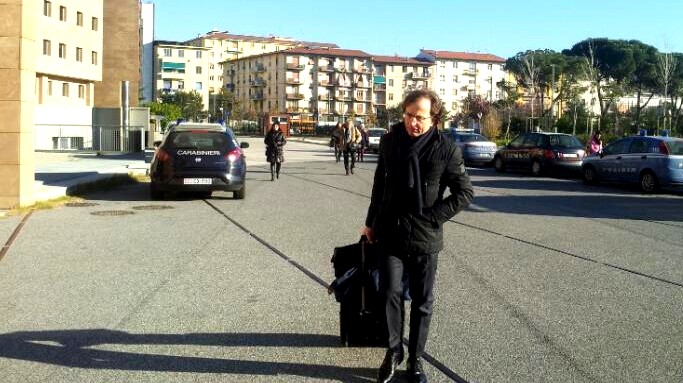
[Above, today: Dr Maresca, the Florence lawyer who speaks for the victim, arrives at the court]
7. Court resumes tomorrow
Court will resume at 9:30 am Italy time with the first of the summations for the defenses. When they conclude, probably in January, the prosecution will have a chance of rebuttal.
6. Reporting in English
Andrea Vogt has posted a detailed report from the court at The Freelance Desk, Scroll down to the heading “Update Dec 1t 2013”
5. Reporting in Italian #3
Amanda Knox and Raffaele Sollecito, accused in the murder of British student Meredith Kercher, were in the grip of a “murderous rage” fuelled by illegal drugs and alcohol, a lawyer for the victim’s family said Monday. Knox, Sollecito and a third person definitively convicted of the crime, Rudy Guede, had “no inhibitions” because of the drugs and alcohol they ingested before murdering Kercher in November 2007, charged Vieri Fabiani.
Only later did the “fear take over” and led to false explanations including a simulated break-in and robbery, and a false accusation against a bar owner in Perugia, where the murder occurred, added Fabiani. A Florence court is trying the case against Knox and Sollecito, who have been on trial twice before for the murder of Kercher. Both have said they are not guilty of the accusations.
Guede was convicted in a fast-track trial and is serving a 16-year sentence in the murder, but Italy’s top appeal court said it was unlikely he acted alone. Knox, who is in the United States and has not returned for this trial, and Sollecito each served two years in prison after a lower court convicted them of murder in 2009. An appeal court overturned those convictions in 2011 and in March, Italy’s highest court sent the case back to the appeals stage over aspects of the evidence it argued had not been properly examined before.
The supreme court ruled that the initial forensic evidence had been wrongly dismissed in the acquittal and a prosecution theory about a sex game that went wrong should be re-examined. Kercher, 21, was found dead on the floor of an apartment she shared with Knox on November 2, 2007. Guede’s DNA was found inside Kercher, on her clothes, and elsewhere in the apartment.
Fabiani said that a motive for the murder was “irrelevant” because the crime was committed while the trio were abusing substances. An Italian prosecutor has requested a 26-year prison term for Knox and Sollecito for the murder, plus a further four years for Knox for allegedly slandering bar owner Patrick Lumumba, whom she initially implicated during tough police questioning before later retracting, saying she had been confused.
The new trial opened in Florence in September, and a decision is expected on January 10.
Translation by The 411
4. Reporting in Italian #2
For the Kercher family it is “intolerable” that Amanda Knox on her website is issuing “invitations to collect donations in memory of Meredith” declared Dr Francesco Maresca, the lawyer for the parents and siblings of Mez, speaking in the Assize Court of Appeal of Florence, where judicial process continues for the murder of the young British student Meredith Kercher, which occurred in Perugia on the night of November 1, 2007 .
Dr Maresca asked the Court “to forget the opposing sides and all that is foreign to the process”, meaning the media coverage of the controversy being generated in the U.S. in the legal defense of Knox, as they should also “forget the statements made in court a few weeks ago by Raffaele Sollecito, who is now returned to a “vacation” in Santo Domingo”
Dr Maresca also pointed the finger at Knox for her book, for which she signed “contracts in the millions” and also retains “a person to handle public relations”. Finally, he invited the Court to also forget “those journalists who are inspired by the freedom of delirium and not the freedom of the press.”
Many elements confirm the original verdict. “We have no doubts about the guilt of the accused - there are so many elements to confirm the sentence”.
The family of Meredith Kercher, said the lawyer, will be in Florence on the day of the judgment of the appeal for the murder of the young British student by the defendants Amanda Knox and Raffaele Sollecito .
This was a heinous crime committed knowingly. “We ask the Court for truth and justice for a heinous crime committed with precise awareness and desire” said the lawyer Vieri Fabiani, one of the lawyers of the Kercher family… “The defendants Amanda Knox and Raffaele Sollecito and Rudy Guede, in the process of killing Meredith Kercher, were “excited and a murderous rage was triggered” because, with the drugs and alcohol taken ” their minds were free of inhibitions”.
Fabiani focused in particular on Rudy Guede also convicted for the murder of Meredith, recalling that the judgment was delivered after the first degree trial in Perugia [in October 2008]. And on the verdict against Guede, Fabiani stated that he was sentenced in collusion with another two who “accidentally” have been identified as Sollecito and Knox, whose responsibility and presence on the scene of the crime are well documented.
Fabiani called Sollecito and Knox persons of “high criminal capacity” who have created the picture of a crime without serious motive. Then after the murder “fear, terror, took over and they set out to simulate a theft, frame Patrick Lumumba, to mystify, however clumsily, to banish from their minds the crime they committed.”
Fabiani argued that the presence of two defendants in the house on Via della Pergola that evening, and their willingness toward murder, were strongly demonstrated.
“The motive becomes irrelevant,” even if it can be identified “in the issues between Amanda and Meredith, which evolved into a sort of punishment of the victim, in an escalation”.
3. Reporting in Italian #1
Amanda Knox, Raffaele Sollecito and Rudy Guede were ” excitedly and this unleashed their homicidal rage ” that tragic night between the first and November 2 of 2007. Vieri Fabiani, one of the lawyers of the Kercher family, during the appeal session in Florence about the murder of Meredith Kercher .
Because of drugs and alcohol their minds were “devoid of inhibitions ,” argued the lawyer, according to whom the defendants should be considered ” persons of a high criminal capacity .” After the murder, fear took over, then they get to simulate a theft, to accuse Lumumba, to mystify to banish from their minds the crime they committed.”
The lawyer explained that the presence of the two defendants at the crime scene and their willingness to commit murder was strongly demonstrated. “The motive becomes almost irrelevant, even though important elements can be identified” in the problems existing between Amanda and Meredith, which “evolved into a sort of punishment of the victim in an escalation”.
For the Kercher family it is “intolerable that Amanda Knox on her website makes invitations to collect donations in memory of Meredith” added the lawyer Maresca. He invited the Court ” to forget the opposing sides and all that is foreign to the process.” The court should “forget” the statements made in court a few weeks ago by ” Raffaele Sollecito who has returned to “a vacation” in Santo Domingo
Avv Maresca also pointed the finger at Amanda and her book thanks to which she ” has signed contracts making her a millionaire.”
2. Tweets from La Nazione
10. Amanda knows the mode of the crime because she was present
9. Motive is irrelevant, the presence of the accused at the scene of the crime is proven
8. Amanda and Raffaele in the grip of the excitement and this triggered the murderous rage
7. It is not sustainable that Rudy Guede is the only murderer
6. The lack of motive is irrelevant, there is evidence of homicidal intent
5. The ruling of the Supreme Court crushed the acquittal of appeal
4. Amanda knew the mode of the murder
3. On the knife found at Sollecito’s house there was the DNA of the victim
2. Contamination of the bra clasp is false (invented)
1. Meredith proceedings: hearing begins. Lawyer Vieri Adriani for the victim family to speak first
1. Tweets from Freelance Andrea Vogt
5. Courtroom nearly empty for closing args of lawyer representing meredith kercher family. Not much interest in their quiet suffering.
4. Maresca: “While we’re here in trial, Sollecito in Santo Domingo & Knox in US taking online donations for victim she’s accused of killing.”
3. Kercher attny Serena Perna: Meredith’s many wounds in many places (from bare hands,from knife, yet not defensive) = multiple attackers.
2. Kercher attny: Motive, or lack thereof, is absolutely irrelevant.1000 different problems could have led to fatal escalation of violence.
1. Right now lawyers for the civil parties (specifically Kercher family) giving closing arguments. Defense is to follow.
[Below: two images in the courtroom from previous sessions]
